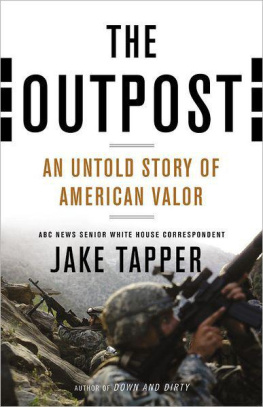Thank you for downloading this Simon & Schuster ebook.
Get a FREE ebook when you join our mailing list. Plus, get updates on new releases, deals, recommended reads, and more from Simon & Schuster. Click below to sign up and see terms and conditions.
CLICK HERE TO SIGN UP
Already a subscriber? Provide your email again so we can register this ebook and send you more of what you like to read. You will continue to receive exclusive offers in your inbox.
We hope you enjoyed reading this Simon & Schuster ebook.
Get a FREE ebook when you join our mailing list. Plus, get updates on new releases, deals, recommended reads, and more from Simon & Schuster. Click below to sign up and see terms and conditions.
CLICK HERE TO SIGN UP
Already a subscriber? Provide your email again so we can register this ebook and send you more of what you like to read. You will continue to receive exclusive offers in your inbox.
ALSO BY C. J. CHIVERS
The Gun

Simon & Schuster
1230 Avenue of the Americas
New York, NY 10020
www.SimonandSchuster.com
Copyright 2018 by C. J. Chivers
All rights reserved, including the right to reproduce this book or portions thereof in any form whatsoever. For information, address Simon & Schuster Subsidiary Rights Department, 1230 Avenue of the Americas, New York, NY 10020.
First Simon & Schuster hardcover edition August 2018
SIMON & SCHUSTER and colophon are registered trademarks of Simon & Schuster, Inc.
For information about special discounts for bulk purchases, please contact Simon & Schuster Special Sales at 1-866-506-1949 or .
The Simon & Schuster Speakers Bureau can bring authors to your live event. For more information, or to book an event, contact the Simon & Schuster Speakers Bureau at 1-866-248-3049 or visit our website at www.simonspeakers.com.
Interior design by Lewelin Polanco
Maps by David Lindroth
Jacket design by Jackie Seow
Jacket photograph by Tyler Hicks
Library of Congress Cataloging-in-Publication Data is available.
ISBN 978-1-4516-7664-8
ISBN 978-1-4516-7667-9 (ebook)
For those who recognize these stories as their own
Why,
it seems like only yesterday, or the day before,
when our vast armada gathered...
The Iliad
America is not at war.
The Marine Corps is at war;
America is at the mall.
handwritten note on the wall of the government center in Ramadi, Iraq, in January 2007
Guide to Maps
Map of Afghanistan
Map of Iraq
Preface
FEBRUARY 14, 2010
Marja, Afghanistan
The American medevac helicopter descended toward a shattered home on the Afghan steppe, sweeping grit against its mud-walled remains. Gunfire cracked past. Inside the ruins, several young infantrymen from Kilo Company, Third Battalion, Sixth Marines, crouched near the bodies of freshly killed civilians. They had tallied eleven corpses so far. All but two were women or children.
Two American rockets had struck here a short while before, a pair of errant blows in a battle between the Marines and the Taliban that had begun in the morning of Valentines Day. In the seconds after, as a dusty smoke cloud rose, a small girl scrambled out. For a moment she stood still. Then she ran, sprinting headlong to another nearby building, which the Americans occupied as a temporary outpost. Her father was detained inside.
Soon Marines were hustling across the field, crossing the open space where a gunfight had raged for hours. When they entered they found one more survivora young woman lying in a pool of blood. She was calling out childrens names. The blasts had severed both her legs and one of her arms. Covered with dirt, streaked with blood, she moaned and repeatedly asked for the kids. She tried sitting up. A corpsman and a few Marines consoled her. A lieutenant and a sergeant with radios called their commanding officer, seeking a Black Hawk medevac aircraft to rush the woman to care. Around her the bodies of her family were scattered where they had died, not far from dead poultry and sheep. Gently the Marines assured the dying woman that all would be okay.
The Pentagon and the manufacturer of the weapon that struck here, known as a HIMARS, consider its ordnance to be precise. Its GPS sensors and guidance system help the rockets fly scores of miles and slam to earth within feet of the coordinates they are programmed to hit. Each carries a high-explosive warhead and a fuze that can be set to burst in the air, maximizing the spread of shrapnel below. The manufacturer markets them as low collateral damage weapons. This is true on practice ranges. Battlefields rarely resemble ranges. More often they are the lands where people live and work, and in this profoundly poor village, the Pentagons precision weapons had hit precisely the wrong place. A sniper had been firing on the Marines from near another home, but the rockets landed here. A family following American instructions stay inside and out of the way had been almost instantly destroyed.
By the time the Black Hawk arrived, the woman had died.
The aircraft flew into a trap.
Automatic fire erupted. Kalashnikov rifles joined in. The Taliban had been waiting, and ambushed the aircraft as its wheels settled toward the ground. The lieutenant and sergeant ran into view, arms waving, warding the pilots off. Their company commander shouted to a radio operator: Abort! Abort! Tell him to abort!
The helicopter lurched forward, gathering speed. A rocket-propelled grenade whooshed into the whirling tower of dust. An explosion boomed behind the Black Hawks tail rotora near miss. The helicopter flew across the field, banked, and put down near the company commander to pick up a wounded Marine, whom the sniper had shot. Then it was gone.
A lull replaced the din. Young men muttered curses. Inside the compound, Afghan soldiers working with the Marines covered the dead with cloth. A Taliban commander, overheard on his own radio frequency, berated his fighters in Pashto for missing the Black Hawk. Hed almost realized his prize. That was your chance! he said.
These Marines were almost all young men on their first enlistments, the type of citizen who serves for four years and returns to civilian life. They were thoroughly trained, visibly fit, thoughtfully equipped, and generally eager to participate in what they were told would be a historic fight, a campaign preordained for American military lore. Most of them were also so new to war that the dead women and children were the first casualties they had seen. Many of them wanted then, and still want now, to connect their battlefield service to something greater than a memory reel of gunfights, explosions, and grievous wounds. They wanted to understand accidental killings as isolated mistakes in a campaign characterized by sound strategy, moral authority, and lasting success. They didnt get this, at least not all of it. Instead, the major general commanding NATO forces in southern Afghanistan circulated a publicly palatable version. The HIMARS rockets, he said, hit the correct building after all. For years the Marine Corps and the Pentagon said little more, even as Marja, seized by Marines and then held by their Afghan army and police partners, returned to Taliban and drug-baron control.
This book is about men and women who served in American combat service in the wars in Afghanistan and Iraq that followed the terrorist attacks on September 11, 2001. It covers these combatants with a simple organizing idea: that they are human. It details personal experiences: what these experiences were, how they unfolded, and what effects they had upon those who were there. And it covers them from their own perspectives, offering their own interpretations of their wars.
Next page












